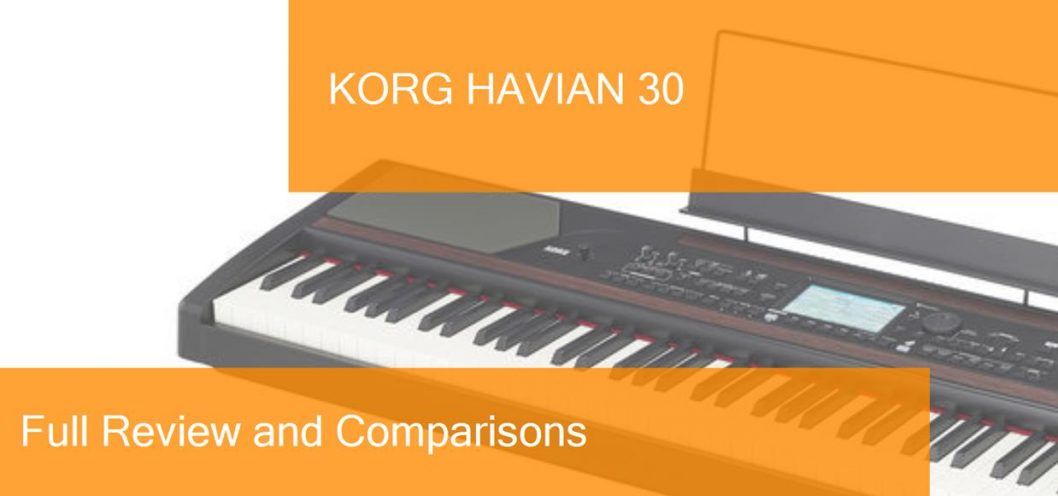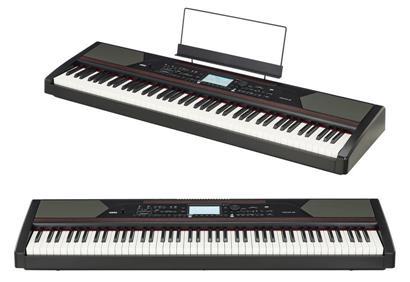
Korg Havian Digital Piano 30 Review Complete. Is it a good choice?
Korg is a Japanese company of electronic musical instruments and guitar tuners. And among their models of keyboards for arrangements we find the Korg Havian 30, which has an approximate price of €1100. And we can already tell you that it is a really interesting digital piano:
- 88 weighted hammer action keys (Weight that the keys of an acoustic piano have and that digital pianos try to imitate to equal the touch of the piano. The keys in the high register are heavier and in the high register less. This is different from the sensitivity on the keyboard which serves to regulate the volume of the note. But a weighted keyboard always has sensitivity in the keys)
- 950 sounds (various piano and other instrument sounds) and variations
- 256 user-configurable sounds
- 420 styles (Accompanying styles that adapt to the chords we are playing. For example they will put a bass and a drum kit that will adapt and synchronize with the notes we are playing on the keyboard) pre-configured
- 128 rhythm kits (Rhythms of accompaniment that adapt to what you are playing. There are bossa nova rhythms, etc. Sometimes they are also known as accompaniment styles) and drums
- 128 notes of polyphony (Number of notes that can be played at once. This includes accompaniments that also consume notes. So if you play over an accompaniment more notes will be accumulated)
- 4 stereo master effect groups
- 125 types of effects
- 3-band equalizer for each track
- Transposition (Transposition allows you to move the note spectrum of a keyboard. This is to be able to play with transposing instruments. It is not an easy concept but it is made to facilitate the writing of an orchestration for instruments with very different bass and treble registers)
- Split function (dividing the keyboard into two different instruments)
- Metronome (Basic study element to study and practice the tempo of a piece of music)
- Full colour screen
- Joystick control for improved usability
- Records MP3 and SMF files. You can record keyboard tracks and effects
- USB midi (MIDI allows you to do such wonderful things as connect your keyboard to your computer, record a sound track and with certain programs click through what you’ve played to musical notes on a score. MIDI tracks store the information of the musical notes)
- USB for pendrives
- Exit hulls
- Sustain pedal (The sustain pedal of a piano or keyboard is used to keep the note playing even if you stop pressing the key)
- 2 super powerful 25W speakers. Tremendous for playing wherever you want without extra amplification
- Includes lectern, network connector, DVD with extras and DS-2H damper pedal used as a sustain
- A weight of 15.1 kg and dimensions of 1312 × 389 × 146mm (width x depth x height)
As we mentioned at the beginning, we found an arrangement keyboard with good functions and performance, its foot pedal and Miri USB function gives them an advantage as it can be used in a music production studio or also in order to study piano in a decent way.
Now that we have listed and described the features of this keyboard there is no better way than to take a look at the following video where they tell us more about the Korg Havian 30 and you can hear how its different sounds sound.
Related post you can be interested in
- Ranking with the best digital pianos
- My selection of cheap musical keyboards.
- Basic concepts you need to know about digital pianos.
- The best resources to learn to play the piano by yourself.
- The best Kawai Digital Pianos.
Now let’s compare the Korg Havian 30 with its more common alternatives. Also at the end of the post you will find a section with the best shopping possibilities for this digital piano. But you can go directly to that part of the post by pressing the following button.
Korg Havian 30 vs Casio PX-560 Privia
First we will buy the digital keyboards: the Korg Havian 30 which as we mentioned has an estimated price of £1100 and the Casio PX-560 Privia which has a very similar price. We will see their features and differences in the following face-to-face:
- Both digital keyboards have 88 hammer-action weighted keys with sensitivity. However the Casio’s have a texture of synthetic ebony and ivory, giving a greater simulation to a real acoustic piano. Therefore the Casio keyboard has an advantage. Let’s remember that the weight of the keys of a real acoustic piano is the weighted keyboard, in the low register it has heavier keys while in the high register they are lighter. Sensitivity refers to the fact that we can play dynamics in our performances, i.e. when we press a key with force it sounds louder than when we press another one with little force that will sound lower.
- When it comes to sound, the Korg has 950 sounds and variations, 256 user-configured sounds and 420 pre-configured accompaniment styles, plus 128 polyphonic notes. On the other hand the Casio has 650 sounds, 220 styles pre-configured for accompaniment and 30 styles that can be configured speech by the user, in addition to 256 notes of polyphony. Polyphony is the largest number of notes that can be played simultaneously in a computer.
- The Korg Havian 30 features: 128 drum and rhythm kits, 4 stereo master effect groups, 125 effect types and a sustain pedal.
- The functions of the Casio PX-560 Privia are Multi-Dimensional Morphing AiR System, Pitch Bend Wheel, Sound Modulation Wheel, a joystick for enhanced control, three-pedal input and a sustain pedal included.
- The Korg has 2 super powerful 25W speakers while the Casio PX-560 Privia has 2 8W speakers.
- The Korg Havian 30 weighs 15.1 kg and measures 1312 × 389 × 146mm (W x D x H) and the Casio PX-560 Privia weighs 12 kg and measures 1322 × 293 × 147mm (H x W x D).
We noticed that we found two good arrangement keyboards, with their respective advantages and disadvantages. On the other hand, the Korg gives us a greater amount of sounds both in terms of precept and configuration of speech by the user, has many defects reaching 125, and has powerful speakers of 25W. While the Casio offers us synthetic ebony and ivory keys, a greater amount of polyphony notes, a multi-dimensional Morphing AiR system, a triple pedal input and a lighter weight making this keyboard very portable. Depending on the user’s needs, a decision will be made, although to be honest the Korg’s 300+ sounds appeal more to me.
We will put the characteristics of each of these pianos in 2 different columns to make it easier to see the differences:
|
Korg Havian 30 |
Casio PX-560 Privia |
|---|---|
|
|
And now a video of the Casio PX-560 Privia
If you want to know more about this model don’t miss our review of the Casio PX-560 Privia.
Korg Havian 30 vs Yamaha DGX-660
Now we will buy these two digital keyboards the already mentioned one that has a price close to €1100 and now the Yamaha DGX-660 that has a price of €749/£685, with a big difference of €365, with a relevant difference, we will see its similarities and differences in the next section:
- Both digital keyboards have 88 hammer-action weighted keys with sensitivity. Let’s remember that weighted keyboard is the weight that the keys of a real acoustic piano have, in the bass register it has heavier keys while in the treble register they are lighter. Sensitivity refers to the fact that we can play dynamics in our performances, that is, when we press a key with force it sounds louder than when we press another one with little force that will sound lower.
- When it comes to sound, the Korg has 950 sounds and variations, 256 user-configured sounds and 420 pre-configured accompaniment styles, plus 128 polyphonic notes. On the other hand the Yamaha has 554 sounds, 205 styles pre-configured for accompaniment, plus 192 notes of polyphony. Polyphony is the largest number of notes that can be played simultaneously on one instrument.
- The functions of the Korg Havian 30 are: 128 rhythm and drum kits, 4 stereo master effect groups, 125 effect types and a sustain pedal.
- The functions of the Yamaha DGX-660 are: 41 reverb effect types, 44 chorus types AND 237 DSP sounds, triple pedal input and sustain pedal included.
- The Korg has a two 25W speaker system, while the Yamaha has two 6W speakers.
- The Korg Havian 30 has a weight of 15.1 kg and dimensions of 1312 × 389 × 146mm (W x D x H) and the Yamaha DGX-660 has a weight of 28Kg and dimensions with the stand of 1399 x 445 x 761mm
Once again we have two good digital pianos, this time the Korg has some more advantages. The Korg offers almost twice the sound and style to go with it, a joystick control, and a very powerful 25W speaker system, which allows us to play very well in an enclosure without extra amplification. For its part, the Yamaha does not offer a greater amount of polyphony notes, a greater amount of effects in general and, most importantly, a triple pedal input.
We will put the characteristics of each of these pianos in 2 different columns to make it easier to see the differences:
|
Korg Havian 30 |
Yamaha DGX-660 |
|---|---|
|
|
And now a video of the Yamaha DGX-660
If you want to know more about this model do not miss our review of the Yamaha DGX-660.
Korg Havian 30 vs Thomann SP-5600
Now we will find the following digital keyboards: the Korg Havian 30 which as we mentioned before has an approximate price of €1100, and the Thomann SP-5600 which has a price of €369/£333, a big difference approximately €730, with such a big difference, we will surely find a big difference in its functions and features too, let’s see:
- Both digital keyboards have 88 hammer-action weighted keys with sensitivity.
- When it comes to sound, the Korg has 950 sounds and variations, 256 user-configured sounds and 420 pre-configured accompaniment styles, plus 128 polyphonic notes. On the other hand, the Thomann has 600 sounds, 230 styles pre-configured for accompaniment and 10 of them configurable, in addition to 128 notes of polyphony.
- The functions of the Korg Havian 30 are: 128 rhythm and drum kits, 4 stereo master effect groups, 125 effect types and a sustain pedal.
- The functions of the Thomann SP-5600 are Effects like Reverb and Chorus, and a microphone input.
- The Korg has a two 25W speaker system, while the Yamaha has two 10W speakers.
- The Korg Havian 30 weighs 15.1 kg and has dimensions of 1312 × 389 × 146mm (W x D x H) and the Thomann SP-5600 weighs almost 14 kg and has dimensions of 1365 x 366 x 137mm (W x D x H)
We found a great difference in keyboards for both quality and price, the Korg takes an extremely great advantage to the Thomann for both its amount of sounds, styles and speaker power. In polyphony both are equal, high very interesting due to its great difference in price. However, for a person with a limited budget, the Thomann SP-5600 is really a great choice.
We will put the characteristics of each of these pianos in 2 different columns to make it easier to see the differences:
|
Korg Havian 30 |
Thomann SP-5600 |
|---|---|
|
|
And now a video of the Thomann SP-5600
If you want to know more about this model don’t miss our review of the Thomann SP-5600.
Korg Havian 30 vs Korg PA-700
Finally we will have the comparison of two keyboards for arrangements of the Korg brand: the Korg Havian 30 that as we have mentioned before has a price of approximately €1100, compared to the Korg PA-700 that has a price of approximately €1.079/£999, reaching a very small difference of about €20, we will see then their similarities and differences in the next face to face:
- The Havian 30 has 88 hammer-action weighted keys and sensitivity, while the Korg PA700 has 61 keys but only sensitivity. This gives the Havian 30 a great advantage.
- In terms of sound, the Korg Havian 30 has 950 sounds and variations, 256 user-configured sounds and 420 pre-configured accompaniment styles, plus 128 polyphonic notes. On the other hand, the Korg PA700 has 1700 sounds and 512 customizable styles, 360 pre-configured accompaniment styles, and 128 polyphonic notes.
- The Korg Havian 30 features: 128 drum and rhythm kits, 4 stereo master effect groups, 125 effect types and a sustain pedal.
- The functions of the Korg PA700 are Sound synthesis technology, Defined Nuance Control, micro SD memory slot, sustain pedal input and other configurable, USB memory input, 2 guitar modes.
- The Korg has a two 25W speaker system, while the Yamaha has two 10W speakers.
- The Korg Havian 30 has a weight of 15.1 kg and dimensions of 1312 × 389 × 146mm (W x D x H) and the Korg PA-700 has a weight of 9.9 kg and dimensions of 1030 x 378.3 x 132mm (W x H x D)
We found two good keyboards for accompaniment, both of the color brand and in certain features each one has its own. The Havian 30 has more keys and the function of which are weighted, a greater amount of rhythms, and the PA 700 for its part has a greater amount of sounds both face and set, certain functions that have no rival and both have a great power in their speakers. So it’s not an easy decision to make. Depending on your needs, you can make the best decision.
We will put the characteristics of each of these pianos in 2 different columns to make it easier to see the differences:
|
Korg Havian 30 |
Korg PA-700 |
|---|---|
|
|
And now a video of the Korg PA-700:
If you want to know more about this model don’t miss our review of the Korg PA-700.
Where to buy Korg Havian 30
Amazon
- Free Shipping and possibility of shipping in one day with Amazon Premium.
- Full Guarantee but they are no experts in music equipment.
- Sometimes better price.
- He’s got worse stock than Thomann.
Thomann
- Free Shipping.
- Full warranty. If you have any problems, they take care of everything.
- 100% reliable payment.
- Leader in trouble-free shipping.
- Usually Best price.
- Best Reputation: They are the leading online store in Europe and have the best catalogue and information.
Check below related models with similar price and features:
- Roland FP 60
- Yamaha P515
- Yamaha YDP 164
- Roland FP 90
- Korg G1 Air
- Casio PX 560
- Roland Kiyola KF 10
- Korg PA 1000
- Korg PA 700 Oriental
- Yamaha PSR S975
- Korg Havian 30
- Korg PA 700
- Kawai EN 8
- Kawai MP 11
- Kawai MP 7
- Clavia Nord Electro 6D 61
- Clavia Nord Stage 3 88
- Kurzweil SP6
- Korg SV1 73
- Kurzweil Forte 8
- Clavia Nord Electro 6D 73
- Clavia Nord Stage 3 HP76
- Roland RD 2000
- Kurzweil Artis 7
- Clavia Nord Piano 4
- Clavia Nord Stage 3 compact
- Crumar Seven
- Clavia Nord Electro 6
- Korg Grandstage 73
- Dexibell Vivo Stage S9
- Dexibell Vivo Stage S1
- Korg SV1 88
- Korg Grandstage 88
- Kurzweil Forte SE
- Yamaha CP88
- Roland VR 730
- Studiologic Numa Concert
- Yamaha CP73
- Dexibell Vivo Stage S7
- Yamaha CP300
- Yamaha CP1
- Clavia Nord Grand
- Viscount Physis Piano K4 EX
- Viscount Physis Piano K5 EX
- Dexibell Vivo Portable P7
- Kurzweil Artis
- Dexibell Vivo Portable P3
- Dexibell Vivo Stage S3


